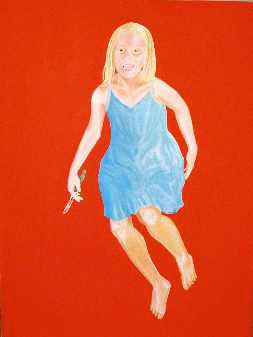Where is Eve?
What happened? “The knife! What have you done, child?” Our attention is first drawn to the girl’s hand holding the knife and then to her face, which we try to interpret. It frightens us, but are we still frightened if we lose sight of the knife and focus only on her face? We cannot tell what is happening, although it seems clear. Kyra Claydon’s paintings are like snapshots: They could be part of a story, but they are as difficult for us to grasp as it would be to reconstruct an unfamiliar story from a single sentence. It would always be the „other affair“.(Nur eine andere). We tolerate open-ended stories only reluctantly of course, those we cannot quite make neither head nor tail of, and all too often we display the shallow tendency towards deep psychoanalysis. We want pictures that fit into a story! „Make it real“. ...
Full Description
Where is Eve?
What happened? “The knife! What have you done, child?” Our attention is first drawn to the girl’s hand holding the knife and then to her face, which we try to interpret. It frightens us, but are we still frightened if we lose sight of the knife and focus only on her face? We cannot tell what is happening, although it seems clear. Kyra Claydon’s paintings are like snapshots: They could be part of a story, but they are as difficult for us to grasp as it would be to reconstruct an unfamiliar story from a single sentence. It would always be the „other affair“.(Nur eine andere). We tolerate open-ended stories only reluctantly of course, those we cannot quite make neither head nor tail of, and all too often we display the shallow tendency towards deep psychoanalysis. We want pictures that fit into a story! „Make it real“. Yet no painting goes deeper than its foundations, so let‘s take a look and think about the background. Kyra Claydon’s paintings are often mostly monochrome, cadmium red, royal blue, perhaps with fluffy, candy-floss clouds, sometimes almost black, or ultramarine, with roses and orchids here and there. But these are most certainly not fluffy. The background gives us no clues about the story however. They reflect and play with the composition of classic ad posters: „Persil is Persil“. Even Claydon’s artistic technique reminds us of painting styles used in advertising. But her painting technique immediately rejects this impression by creating another impression of seemingly naïve, awkward figures. Of course, these paintings refuse the world of advertising, and dare to do it by exploiting ideas from advertising compositions. The backgrounds do not want to advertise their foregrounds. In contrast to the many “realists” from Leipzig and elsewhere, Kyra Claydon refuses to put her figures in a context of social reality, but there is also no definite reality. Her figures do not have any ground to stand on in terms of fixed positions. “Make it real”. They hover in the forefront, as I said, sometimes among the clouds, just airy shapes.
Eve has gone Her paintings are not completely without context of course. It is just that to read this context is as lighthearted, yet as serious, as reading a text in which one sentence comes waltzing down a red carpet, while the next one pulls this carpet from under it with an ironic laugh. Let’s take a look at “Lilith and Adam”. Lilith, according to the legend that lives on outside the holy books, was Adam’s first wife. And she was not made from his rib. Looking at the frog we have no trouble calling to mind “The Frog King” by the brothers Grimm. When we look between the girl’s face, her left hand and the frog, there can be no doubt that there is a problem in the relationship between them. But what is it? Lilith’s face shows both intelligence and severity, her body is awkward and naïve, her arms chubby, obviously she is not a woman.Who opts for the snake of seduction? but not really. What game is actually being played here? Does Lilith, the king’s daughter from the old fairy tale, transform herself into something new, and others into frogs? Is the “Flying Witch” grown up? In the cabala, Lilith is the queen of the night, of evil and mother of many demons. In this painting she is a woman for sure. But where is Adam, the frog, a man? We have already talked about posters, and this is not an advert: the eroticism of these paintings has nothing to do with either the housewife or Lolita and Lulu.
The undistorted view But we are definitely dealing with another fairy tale here, Anderson’s “The Emperor’s New Clothes”, namely those new clothes of the mainstream. He initially ended the story with everybody admiring the emperor’s new clothes. Yet no-one wanted to show that he was unsuitable for office or was unforgivably stupid by demonstrating either his skepticism or his clear view. But after all, Anderson did give us the original model for an intellectual, an artist, in the form of a small child exclaiming, “But he hasn’t got anything on!” He must have pointed with his finger in exactly the same way as the “Hovering Diva”. The plushy hem of her white and red skirt - you can almost feel the upward lift - is jetting her away, singing and laughing, out of this reality. In any case out of a world where you cannot consider “nothingness” as nothing if you do not want to fall into the void. ...And the hovering Diva is a vamp.
Prof. Dr Hans-Joachim Strauch (Translation: Dr. Jeremy Gaines)
Work metadata
- Year Created: 2009
- Submitted to ArtBase: Monday Nov 16th, 2009
- Original Url: http://kyraclaydon.wordpress.com/
- Permalink: http://kyraclaydon.wordpress.com/
-
Work Credits:
- Kyra Claydon, creator
Take full advantage of the ArtBase by Becoming a Member





